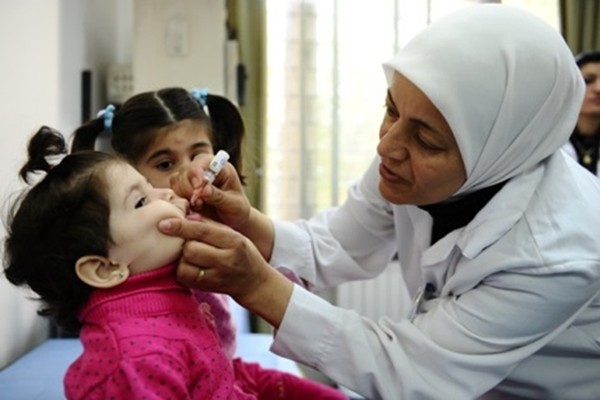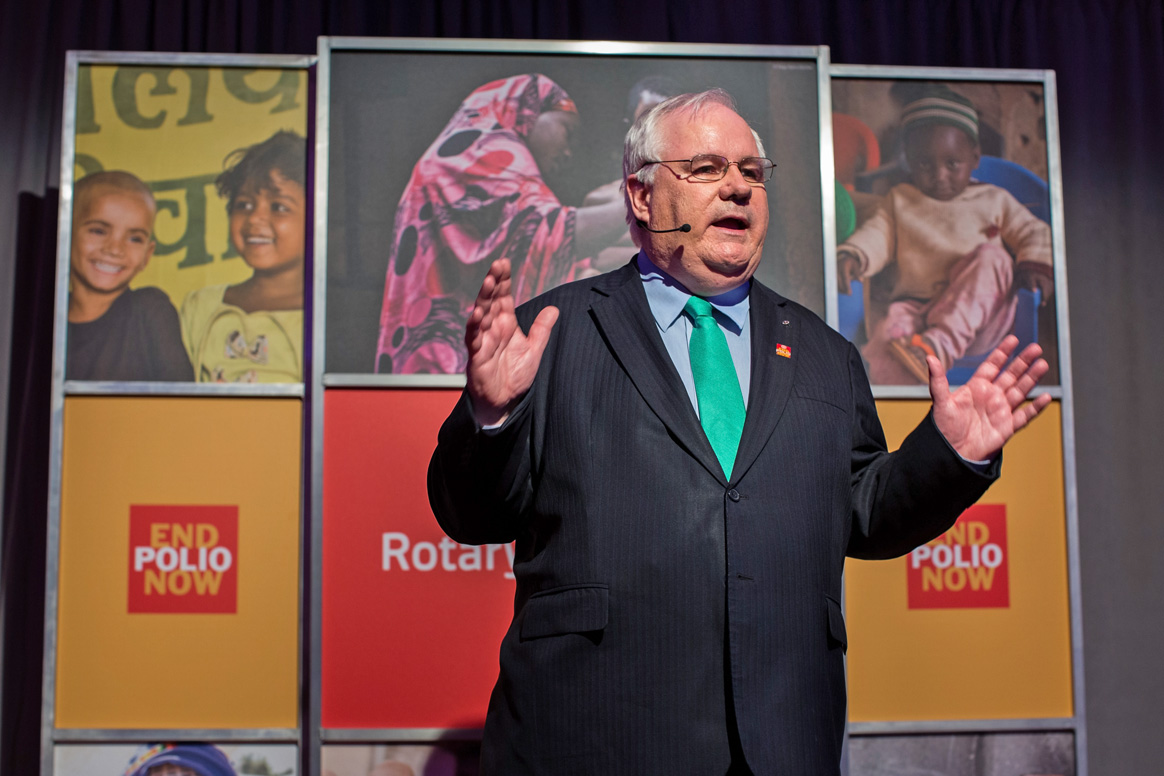The paralysis of children by polio throws into sharp relief the damage to the country’s health infrastructure and the impact of that on the health of the Syrian people

The ongoing outbreak of polio in Syria is one of the most challenging and visible outbreaks in the history of polio eradication. The paralysis of children by polio throws into sharp relief the damage to the country’s health infrastructure and the impact of that on the health of the Syrian people. When society and order become precarious, health systems break down and people suffer from the effects. Syria has been no exception.
Media reports over the past few months have raised questions about the work of the World Health Organization in Syria, particularly as regards response to the outbreak of polio. The table below is intended to answer some of these questions, recognizing the scale of the crisis and the challenge of what is happening in Syria.
Related
Polio in Syria (The Lancet )
New polio vaccination round begun in Syria
Questions and AnswersWorld Health Organization & United Nations Agency support to the Syrian crisis & polio outbreak |
dowload as PDF
QUESTION |
ANSWER |
| Is it true WHO is unable to be impartial and can only operate in government-held territories in Syria? | WHO is completely impartial in aiding communities on all sides of any conflict, in accordance with international humanitarian principles. In Syria, WHO works with over 30 local and international NGOs, UN agencies including UNICEF, civil society groups, the Syrian Arab Red Crescent Society and other humanitarian partners to deliver medicines, vaccines and medical supplies, to coordinate the delivery of health care, to train health workers, and to prevent and control outbreaks of disease. These efforts have assisted millions of people on all sides of this conflict. During 2013, for example, WHO distributed sufficient medicines to meet the needs of 4.6 million people. |
| Did WHO only announce the polio outbreak in Syria in October 2013, even though the first case occurred in Aleppo in July 2013? | In areas which have long been polio-free, such as Syria, those who detect and report polio (clinicians, lab technicians, etc.) have a “low index of suspicion”, meaning they tend not to assume polio is the cause of paralysis. Unfortunately therefore, a child may go undiagnosed for some time; this was the case for the child in Aleppo, who was reported to have developed acute flaccid paralysis on 14 July 2013. Samples from this case were collected only in September, and sent for testing in October. The case was reported only after a cluster of paralyzed children were detected in Deir Al Zour governorate in October.WHO was first notified of this cluster on 11 October, and preliminary laboratory results on 17 October suggested the presence of poliovirus. WHO issued an international alert on the risk of a polio outbreak on 19 October. The Government of Syria reported virologically-confirmed cases on 29 October. |
| Did WHO prevent polio samples from being tested in Turkey? | WHO considers results from all WHO-accredited laboratories in assessing the international risk posed by any polio outbreak as well as for additional response requirements. Turkey has a WHO-accredited laboratory (part of WHO’s European regional network, as Turkey belongs to the European Region).The Government of Syria, however, accepts results from the regional laboratory system for the Eastern Mediterranean, as Syria is a part of the WHO Eastern Mediterranean Region, which does not include Turkey. For this reason, WHO continues to work so that the results of samples potentially tested outside of the Eastern Mediterranean but in laboratories recognized by the Government of Syria can be included in national figures. |
| Were areas under opposition control, such as Deir Al Zour, not included in earlier national vaccination campaigns? | Since 2010, at least two immunization campaigns have been conducted every year across Syria. All national campaigns strive to reach all areas of the country, including those under opposition control. Activities in some areas of a country may be deferred due to a number of reasons, including active fighting or insecurity. Such areas are then tracked, and re-covered as rapidly as possible. For example, in the national campaign of December 2012, Deir Al Zour activities were deferred; the governorate was covered one month later in January 2013, and 67,000 children were vaccinated.Within five days of WHO’s polio alert on 19 October 2013 a vaccination campaign was launched, reaching an estimated 2.2 million children, including a reported 600,000 from Al-Raqqa, Rural Damascus and Deir Al Zour. Three vaccination rounds have now been conducted in Syria. The most recent national round, in January 2014, was carried out in all Governorates.Preliminary results suggest that vaccine coverage was greater than 85% in all but three of Syria’s governorates, and that coverage was greater than 75% in two of those three. |
| Was WHO insufficiently prepared for the possibility of a poliovirus importation and an outbreak? | Preventing and controlling infectious diseases such as polio has been one of WHO’s main priorities since the outset of the Syria crisis. Recognizing the increasing risk of polio and other vaccine-preventable diseases, WHO, UNICEF and partners helped organize and support at least 2 immunization campaigns every year within Syria since 2010. In the surrounding countries, mass campaigns with the oral polio vaccine (OPV) were conducted in areas of low routine immunization coverage, while refugees arriving at registration points or camps were systematically vaccinated by host governments or the United Nations High Commission for Refugees (UNHCR). Within five days of WHO’s polio alert on 19 October 2013, a vaccination campaign was launched, reaching an estimated 2.2 million Syrian children.WHO has also established an early warning and response system for outbreaks that now has over 450 reporting sites throughout the country, many of which are in opposition areas. During 2013 WHO trained nearly 1,000 health workers on a range of topics related to infectious diseases, including on early warning and on outbreak response. |
| Does WHO underestimate the number of polio cases? | In order to plan and implement effective outbreak response, there must be a complete and accurate understanding of the extent of wild poliovirus transmission. That is why WHO uses a broad case definition (‘acute flaccid paralysis’) to find all possible cases of polio. Because acute flaccid paralysis can have a number of causes other than poliovirus, only virological testing confirms a case of polio.In assessing the geographic extent and risk of polio, WHO considers viruses reported by the Government of Syria (23 cases as of 30 January) and all other sources (13 cases as of 30 January). Given the challenges of obtaining adequate laboratory samples in conflict settings, WHO also examines clusters of “polio-compatible” cases to help guide national and international outbreak response planning. Recognizing that in settings of conflict and humanitarian emergencies there are gaps in disease surveillance, all vaccination campaigns planned in Syria are nationwide, to ensure that children in areas with undetected transmission are also fully protected. |
| Does WHO have no plan for Lebanon and other surrounding countries which are overrun by refugees and have overburdened health systems? | Since the start of the Syrian crisis, WHO has worked with all refugee-hosting countries and agencies (especially UNHCR) to ensure vaccination of arriving refugees and to hold supplementary immunization activities – especially since the detection of poliovirus of Pakistani origin in the sewage in Cairo in January 2012. Even before the Syrian cases, WHO and UNICEF were assisting neighbouring countries to plan and implement supplementary immunization activities.The day after confirmation of the polio outbreak, Ministers of Health from across the region declared polio a regional public health emergency on 30 October. A multi-country strategic plan for the outbreak has been developed to reach more than 22 million children multiple times across seven countries. It is the largest ever immunization response across the Middle East, and includes vaccination for refugees registered in camps as well as in host communities and for the host communities themselves. The Middle East emergency outbreak response plan is available online. |
| Is it true that WHO and the US CDC have not coordinated their disease surveillance support to Syrian populations? | WHO and CDC are two of the spearheading partners of the Global Polio Eradication Initiative and work closely in the Inter-Agency Standing Committee’s Global Health Cluster. Their close collaboration in humanitarian emergencies, disease outbreaks and polio eradication has a long history. In this crisis, CDC has worked outside Syria to support capacity for the Early Warning System for Disease Outbreaks (EWARS), while WHO has worked within the country. Personnel and offices of both agencies are collaborating closely on the response to the Middle East polio outbreak. |
| Do WHO representatives avoid contradicting governments? | Heads of WHO Country Offices have dual responsibilities to work with Governments to protect health in the country and also to take those actions necessary to protect global health. |



